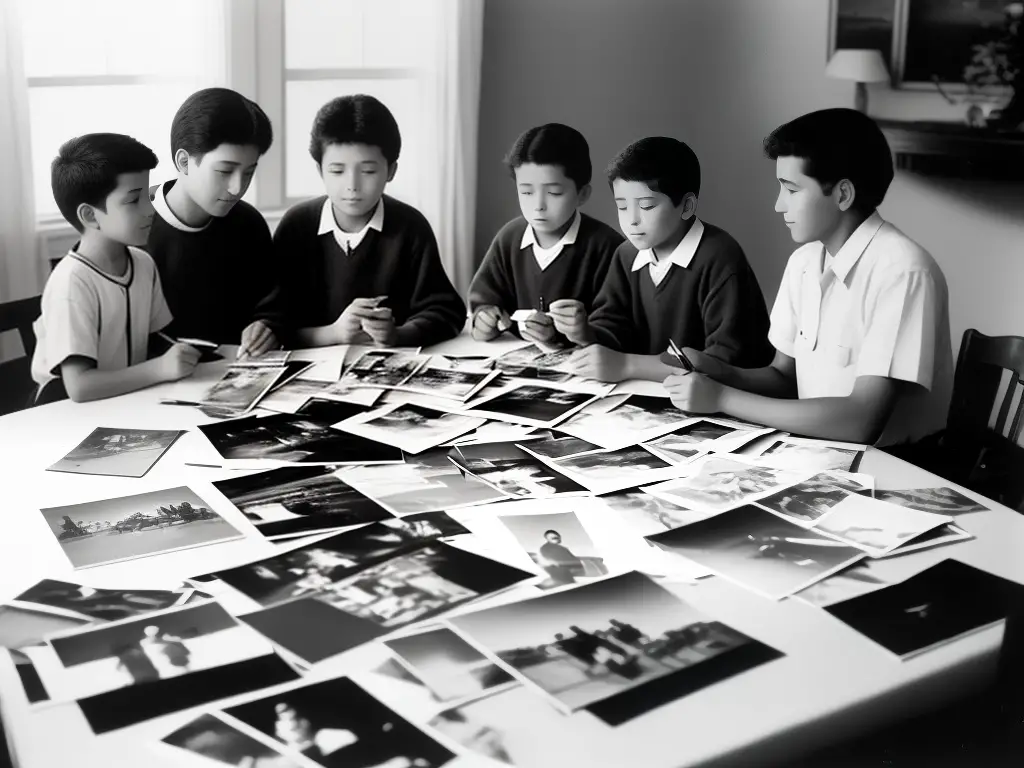Family reunions are a special time when loved ones gather to celebrate their shared history and heritage, with many taking place in conventional settings and following traditional formats. However, some families have experienced remarkably unexpected or extraordinary reunions that have made headlines and captivated people’s hearts around the world. These fascinating events not only explore the incredible genetic connections and cultural traditions that bind families together, but also reveal inspiring stories of individuals who have reunited with lost relatives through the power of science, technology, and personal determination.
Amazing Stories of Family Reunions
One of the most bizarre family reunions in history took place in 1988 with the Kirby family in Australia. The family initially consisted of John and Mary Kirby, who had eight children. After several decades of not knowing the existence of one another, all ten siblings were miraculously reunited. The main reason behind the separation was Mary’s belief that her husband couldn’t take care of the big family. Therefore, she abandoned him and secretly placed the children for adoption one after the other. After many years when John found out about his children, he reached out to them via radio interviews and social media. As a result, all siblings found each other, and they finally had a grand reunion, forming the largest living family in the world at the time.
In a peculiar twist of fate, two Korean-born individual siblings Zach and Genny Baird were adopted by different American families in 1983. With no knowledge of their biological family, they grew up in different states, unknowingly living only four hours apart. In college, Zach’s adopted sister shared a Facebook post about her brother’s search for his biological family. Astonishingly, the same adoption agency placed both children, and a rare coincidence led Genny to see the shared post on Facebook. She reached out in disbelief, and a DNA test later confirmed their relationship, leading to an emotional reunion.
Another fascinating family reunion story started with an accidental discovery through DNA testing. Alice Plebuch, a lady from Washington, discovered that her DNA did not match her expected Irish and English heritage, but instead showed a strong Ashkenazi Jewish ancestry. This unexpected revelation led her on a journey to find her long-lost relatives, ultimately piecing together her family tree. It turned out that her father’s DNA had been mistakenly swapped with another baby at the hospital. The two families affected by this unexpected situation eventually came together, meeting their siblings over 100 years later, celebrating their newfound connections.
In 2018, a bizarre family reunion occurred after a 39-year gap between a mother and daughter. A young lady, Denise, was kidnapped as a 3-week-old baby from a Chicago hospital by a woman who faked being a nurse. She was then taken to Nashville and given a new identity. By tracking down the birth certificate discrepancies and conducting a DNA test with a genetic testing company, Denise discovered her true biological family, reuniting with her mother after almost four decades.
In the midst of the chaos and disarray of World War II, a Polish soldier named Stanislaw Galka was separated from his family when his wife and two daughters were forcibly taken by German officials. Galka eventually remarried and relocated to the United States, thinking he had lost his family forever. However, four decades later, letters exchanged between Poland and the United States revealed the whereabouts of his family. This led to a heartwarming reunion between the father and the two daughters, Emilia and Guzalia, after 44 years of separation.

Unique Family Reunion Traditions from Around the World
Across the globe, peculiar family reunion traditions such as paagaw in the Philippines showcase the strong bond between families. During paagaw, attendees throw coins, candy, and other small items to children and other family members, signifying abundance and prosperity. Family members scramble to grab as many of these gifts as they can, creating a strange and delightful sight. More popular in rural areas, paagaw has become somewhat of a tourist attraction, drawing visitors to witness and join in the fun. Apart from this lively tradition, Filipino family reunions, like most others, also consist of festive foods, singing, and dancing, emphasizing the importance of reconnecting with loved ones, as seen with Stanislaw Galka’s family reunion.
In France, the annual celebration of “La Cousinade” can take on a grand scale, reuniting families in large gatherings. Typically organized by one or more family members, the event can include hundreds of participants and can take months of planning. In these grand celebrations, French family members bond through a series of activities such as heritage tours, picnics, and games. La Cousinade is not only an opportunity for extended family members to get reacquainted but also a chance for younger generations to learn about their ancestral roots and historical connections.
Among the African-American community, annual family reunions are celebrated with much enthusiasm and joy, following the tradition of the homecoming. The concept of homecoming dates back to the early 20th century when African-American families who migrated to Northern American cities would return to their ancestral homes in the Southern United States for special occasions. Today, African-American family reunions often include a mix of traditional foods, music, and cultural practices, such as storytelling sessions about family history and discussions on genealogy. Some families even arrange for trips to Africa and visit the villages where their ancestors once lived.
In Ireland, the “Gathering” tradition brings families together to celebrate their ancestral roots and heritage through various events and festivals. Family members from across the globe reconnect and engage in cultural activities such as traditional Irish music, dancing, sports, storytelling, and exhibitions showcasing family history. In addition to providing an opportunity to strengthen family bonds and preserve cultural traditions, the Gathering also supports the tourism industry and local economy, as many family members travel to Ireland for these reunions.
The Embera tribe of Panama hosts an extraordinary family reunion known as ‘La Mingueta,’ a celebration of the tribe’s unity and rich cultural heritage. The event features a variety of activities that bring family members together, including canoe races, traditional crafts, and storytelling sessions. These oral history and legend sharing opportunities allow the community to pass on their cultural values to younger generations. Traditional music, dancing, and communal food preparation further showcase the tribe’s strong indigenous identity and customs, making La Mingueta an unforgettable bonding experience.

The Power of DNA Testing for Family Connections
Similar to the importance of cultural connections showcased in events like La Mingueta, genetic connections have long piqued people’s interests as family bonds offer a deep sense of belonging and understanding. Thanks to advancements in science and technology, DNA testing has become a popular and accessible method for people to explore their genetic makeup and uncover hidden familial links. DNA tests analyze unique genetic variations, such as short tandem repeats (STR) or single nucleotide polymorphisms (SNP), and compare these markers against databases of genetic information to potentially establish connections to relatives and trace ancestral lineage back multiple generations. This has led to some of the strangest and most intriguing family reunions in history.
The Two Major Types of DNA Testing
It is essential to recognize that there are two major types of DNA testing that can be used to uncover unknown family members: autosomal and Y-chromosome or mitochondrial testing. Autosomal DNA testing examines chromosomes inherited from both parents and can identify relatives from either side of the family tree. Y-chromosome testing is exclusive to males, as it examines the Y-chromosome inherited from the father and traces the paternal line. Conversely, mitochondrial testing traces the maternal line through the examination of mitochondrial DNA, which is inherited solely from the mother. These two types of tests are particularly useful in connecting distant relatives or establishing links to ancestors from specific regions of the world.
The Discovery of Unknown Family Members
DNA testing has led to several remarkable discoveries and reunited long-lost family members, even in cases where adoptees are searching for their biological parents. Notable examples include siblings who were separated at a young age or family members who were unaware of each other’s existence due to various circumstances, such as war, migration, or secretive adoptions. Given the vast amount of genetic information now available, individuals are increasingly taking advantage of this technology to delve into their family histories and build connections they never knew existed.
Limitations and Ethical Implications
However, these tests are not without their limitations and ethical implications. It is important to acknowledge that not all DNA tests are equal, and the accuracy of results can vary depending on the testing company and the size of their reference database. Additionally, DNA tests only provide probabilities and cannot guarantee with absolute certainty the degree of relation between individuals; false positives and negatives are entirely possible. Furthermore, these tests can also uncover unexpected or even shocking results, such as infidelity, hidden adoptions, or biological parents who were previously unknown. These revelations may lead to the violation of an individual’s privacy and cause emotional turmoil for the parties involved.
Conclusion
DNA testing presents an exciting prospect for individuals seeking to discover unknown family members and strengthen connections to their roots. However, it is essential to approach these tests with caution, understanding their limitations and the potential ethical implications that may arise. Adoption reunions can lead to incredible, heartwarming stories of reconnection and love as biological families come together after years or even decades apart.

Heartwarming Stories of Adoption Reunions
One such story that stands out involves a mother and daughter who found each other again – only to learn that they had been unknowingly working in the same building for four years before discovering their relationship. Mother and daughter were absolutely stunned by this surreal coincidence but now treasure the bond they’ve been able to form as a result of their emotional reunion. By evaluating the necessity and potential consequences of such tests, individuals can make informed decisions about whether to embark on this journey into their family’s history and possibly attend their strangest family reunion yet.
Another inspiring story is that of a man who was reunited with his biological siblings after decades of thinking he was an only child. Having been adopted as an infant, he grew up unaware of his heritage and siblings. When the siblings finally found each other online using genealogy tools, they discovered they had a lot in common despite growing up in different households. Their reunion was bittersweet, but the love and affection they had for one another were undeniable. This unexpected family reunion brought joy and closure to their lives, allowing them to create new bonds and memories together.
Adoption and reunions are not always seamless, and the emotions experienced throughout the process can be challenging. For a woman who discovered that her biological father was her childhood neighbor, it was a mix of shock, relief, and confusion. Growing up, she had always felt a strong connection to him, but never knew the reason behind it. When they reunited, they navigated through these complex emotions as best they could, ultimately strengthening their newly found father-daughter relationship.
The stories of adoptees who located and reunited with their birth parents after a natural disaster are equally powerful. In one such scenario, a young woman who lost her home in a hurricane urgently needed to find a new place to live. Through an online search, she discovered her biological mother’s whereabouts and reached out for help, knowing they were strangers to each other. In a heartwarming twist of fate, her biological mother welcomed her with open arms, ultimately helping her rebuild her life after the devastating storm.
In some unique cases, family reunions can shed light on astonishing secrets. For one woman, her mother’s deathbed confession revealed that she had a twin sister who’d been given up for adoption. Determined to find her unknown sister, she spent three years searching before finally reuniting with her long-lost twin. The story took an even stranger turn when they discovered they had both married men with the same name, studied the same college course, and worked in the same industry. As they delved further into their parallel lives, they were amazed to find that their journeys had been strikingly similar despite growing up apart. This unusual story highlights the untold wonders of reunion between adopted individuals and their biological families.

The Role of Technology in Connecting Families
Technological advancements have played a significant role in facilitating such incredible family reunions. Social media platforms, such as Facebook and Instagram, genealogy websites like Ancestry.com and 23andMe, and various online resources have all contributed to the ease of locating and connecting with long-lost relatives. As a result, the chances of finding missing family members or long-lost friends have increased exponentially in recent years. With each new development in technology, people are able to dig deeper into family secrets and uncover hidden stories, resulting in even more heartwarming and captivating reunion tales.
One compelling example of a strange family reunion facilitated by technology involved a woman who discovered her long-lost brother through a DNA test. After being separated for nearly four decades, the siblings were reunited thanks to advances in genetic testing technology. By submitting their DNA samples to a genealogy website and matching their genetic sequences, the long-separated siblings found each other, leading to an emotional and unforgettable family reunion. This story is just one example of how easily technology is able to connect people and make the impossible become possible.
More recently, social media has played an essential role in helping individuals find their extended family members. Platforms like Facebook allow users to join groups dedicated to specific family names, regions, or ancestry research. By leveraging the power of social media and global connectedness, individuals from all over the world can share and exchange information with others who are searching for their long-lost relatives. Moreover, specialized search tools and websites, such as MyHeritage and PeopleFinders, enable users to locate distant family members by searching for specific names, dates of birth, or other identifying information.
Technology has not only made it easier to find lost relatives but has also broadened the scope of family reunions by bringing together family members from different countries and cultures. For instance, through DNA testing, social media connections, and genealogy research, individuals can now discover relatives living in entirely different parts of the world. As a result, such reunions provide a unique opportunity to bridge cultural gaps and celebrate shared family history, forging new connections that would not have been possible in the past.
At the heart of strange and fascinating family reunions lie countless stories of love, loss, and resilience. For many individuals, reconnecting with long-lost relatives symbolizes hope, healing, and closure. These unexpected reunions could involve reuniting with a sibling separated decades ago, discovering a long-lost parent, or connecting with distant relatives across the globe. Technology continues to break down barriers and bring families together in ways never before imagined.

Planning an Unconventional Family Reunion
Moreover, planning an unconventional family reunion can lead to an unforgettable experience that strengthens familial bonds. One approach is by choosing a unique theme that incorporates the family’s interests, hobbies, or heritage. For instance, a reunion focused on a popular film franchise or historical period can include activities, decorations, and costumes that celebrate the shared interest. These conversation-starters will encourage bonding and help create lasting memories among family members.
Selecting an unusual location for hosting the family reunion can greatly contribute to creating an unconventional experience. Instead of merely gathering at a local park or community center, consider renting a rustic cabin in the mountains, taking a group cruise, or organizing a camping trip in the wilderness. These unique settings promise memorable adventures and encourage family members to bond over new experiences. If budget constraints limit the possibilities, even converting a backyard into a “tropical paradise” or local park into a “circus ground” can make the reunion unconventional and engaging.
Incorporating creative and unusual activities can emphasize the unconventional theme and engage family members of all ages. Ideas can include organizing a family talent show, setting up a scavenger hunt, creating a DIY escape room, or offering art workshops such as pottery or painting. Moreover, try to incorporate team events that require collaboration and communication, like group relay races or building projects, for more bonding among family members.
Another way to ensure a memorable experience is to document the reunion by appointing a designated family historian or hiring a professional photographer or videographer. This individual can capture candid moments throughout the event that attendees may overlook. Additionally, set up a “memory corner” where family members can share stories, pictures, and memorabilia to celebrate their shared history and family roots. This space might also include a family tree or map illustrating the family’s origins and migrations over time.
Embracing the unconventional can lead to a one-of-a-kind family reunion that will be fondly remembered for years to come. By considering the interests and desires of family members, the reunion can be tailored to create a unique experience that ties the family closer together. Overall, the key to a successful and unforgettable family reunion lies in the willingness to think outside the box and foster meaningful connections between family members.

As we’ve seen, there are countless amazing stories of unique family reunions that have left an indelible mark on the collective consciousness, and the many different ways that people locate and connect with their relatives are a testament to the enduring human desire for familial connection. Whether it’s through the fascinating world of genetics and DNA testing, the touching tales of adoption reunions, or the creative and unconventional ways families choose to celebrate their connection, these extraordinary events remind us that family is far more complex and diverse than we ever imagined, and sometimes borders on the truly strange and wonderful. At their core, these reunions remind us of the ever-evolving and deeply personal nature of family, which continues to astonish and inspire.